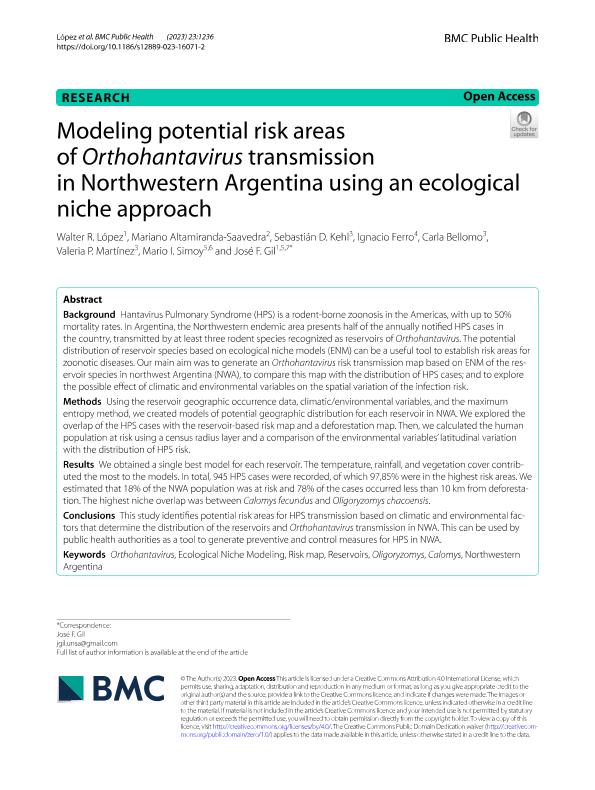Artículo
Modeling potential risk areas of Orthohantavirus transmission in Northwestern Argentina using an ecological niche approach
López, Walter Rodrigo ; Altamiranda Saavedra, Mariano; Kehl, Sebastián D.; Ferro, Luis Ignacio
; Altamiranda Saavedra, Mariano; Kehl, Sebastián D.; Ferro, Luis Ignacio ; Bellomo, Carla María; Martínez, Valeria P.; Simoy, Mario Ignacio
; Bellomo, Carla María; Martínez, Valeria P.; Simoy, Mario Ignacio ; Gil, José Fernando
; Gil, José Fernando
 ; Altamiranda Saavedra, Mariano; Kehl, Sebastián D.; Ferro, Luis Ignacio
; Altamiranda Saavedra, Mariano; Kehl, Sebastián D.; Ferro, Luis Ignacio ; Bellomo, Carla María; Martínez, Valeria P.; Simoy, Mario Ignacio
; Bellomo, Carla María; Martínez, Valeria P.; Simoy, Mario Ignacio ; Gil, José Fernando
; Gil, José Fernando
Fecha de publicación:
12/2023
Editorial:
BioMed Central
Revista:
BMC Public Health
ISSN:
1471-2458
Idioma:
Inglés
Tipo de recurso:
Artículo publicado
Clasificación temática:
Resumen
Background: Hantavirus Pulmonary Syndrome (HPS) is a rodent-borne zoonosis in the Americas, with up to 50% mortality rates. In Argentina, the Northwestern endemic area presents half of the annually notified HPS cases in the country, transmitted by at least three rodent species recognized as reservoirs of Orthohantavirus. The potential distribution of reservoir species based on ecological niche models (ENM) can be a useful tool to establish risk areas for zoonotic diseases. Our main aim was to generate an Orthohantavirus risk transmission map based on ENM of the reservoir species in northwest Argentina (NWA), to compare this map with the distribution of HPS cases; and to explore the possible effect of climatic and environmental variables on the spatial variation of the infection risk. Methods: Using the reservoir geographic occurrence data, climatic/environmental variables, and the maximum entropy method, we created models of potential geographic distribution for each reservoir in NWA. We explored the overlap of the HPS cases with the reservoir-based risk map and a deforestation map. Then, we calculated the human population at risk using a census radius layer and a comparison of the environmental variables’ latitudinal variation with the distribution of HPS risk. Results: We obtained a single best model for each reservoir. The temperature, rainfall, and vegetation cover contributed the most to the models. In total, 945 HPS cases were recorded, of which 97,85% were in the highest risk areas. We estimated that 18% of the NWA population was at risk and 78% of the cases occurred less than 10 km from deforestation. The highest niche overlap was between Calomys fecundus and Oligoryzomys chacoensis. Conclusions: This study identifies potential risk areas for HPS transmission based on climatic and environmental factors that determine the distribution of the reservoirs and Orthohantavirus transmission in NWA. This can be used by public health authorities as a tool to generate preventive and control measures for HPS in NWA.
Archivos asociados
Licencia
Identificadores
Colecciones
Articulos(CCT - TANDIL)
Articulos de CTRO CIENTIFICO TECNOLOGICO CONICET - TANDIL
Articulos de CTRO CIENTIFICO TECNOLOGICO CONICET - TANDIL
Articulos(INECOA)
Articulos de INSTITUTO DE ECORREGIONES ANDINAS
Articulos de INSTITUTO DE ECORREGIONES ANDINAS
Articulos(INENCO)
Articulos de INST.DE INVEST.EN ENERGIA NO CONVENCIONAL
Articulos de INST.DE INVEST.EN ENERGIA NO CONVENCIONAL
Citación
López, Walter Rodrigo; Altamiranda Saavedra, Mariano; Kehl, Sebastián D.; Ferro, Luis Ignacio; Bellomo, Carla María; et al.; Modeling potential risk areas of Orthohantavirus transmission in Northwestern Argentina using an ecological niche approach; BioMed Central; BMC Public Health; 23; 1; 12-2023; 1-14
Compartir
Altmétricas



